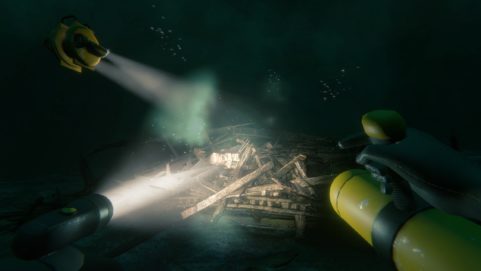A virtual dive into rediscovered history
The Swedish flagship Mars, or “the Magnificent”, sank into the depths of the Baltic Sea more than 400 years ago. Scientists want to make its wreck accessible for the public to experience, but salvaging is too risky. A virtual reality application now lets everyone explore what was once the largest warship in Europe.
In spring 2011, a diving expedition made a sensational discovery! After 20 years of searching, the Ocean Discovery team identified the wreck of the Mars at a depth of about 80 meters near Öland, Sweden. However, due to excessive costs and the risk of damaging the amazingly well-preserved wreck, salvage was simply not an option. Instead, the diving and archaeology team documented it in great detail photographically and, consecutively, the Berlin-based specialists realities.io converted it into a digital photogrammetry reconstruction.
This digital twin of the mighty battleship can now be explored by everyone in the VR application Warship Mars. Equipped with a diving scooter, the user goes into the depths of the Baltic Sea to photograph the secrets and artifacts of the Mars and then analyze them in the virtual research lab. There, exciting photographs curated by scientists, background information and scenic illustrations reveal more about the ship’s history.
We developed the application as part of the Global Historical Archive in cooperation with Facebook. It is intended to be easily experienced by anyone at home, which is why the Oculus Quest was specifically chosen as the target platform.
Magnificent technology
Due to the hardware limitations that come with a mobile VR headset, performance optimization of the photogrammetry model was one of the biggest challenges of the entire project. In our talk at the TNG Techday we explain this in detail along with what other special challenges occurred regarding the design of the virtual underwater expedition.
For this technologically innovative approach to educational material and archaeological research in XR, Mars was awarded 3rd place in the Hugo Junkers award in the category “Most Innovative Projects from the Field of Applied Interactive Technologies”.
Behind the scenes
In addition to the digital wreck other objects, such as grenades, a grapnel, silver coins, the capstan, chain shots, etc. were created to depict life at sea at the time. Of course, these models also had to be optimized for use in VR, but most importantly, they had to be historically accurate. The latter was ensured by a constant exchange with the specialists from Ocean Discovery.
PeriodJanuary - December 2019
ClientRealities.io
TeamFelix Herbst, Marvin Podsendek, Felix Reinemann
CooperationOcean Discovery, Universität Stockholm, Facebook
LinksOcean Discovery Realities.io Stockholm University Felix Stief
Quill Artist Felix Stief
Photogrammetry David Finsterwalder, Daniel Sproll, Azad Balabanian
Ocean Exploration Ingemar Lundgren
Consultants Johan Rönnby, Rolf Warming, Niklas Eriksson, Ingvar Sjöblom






